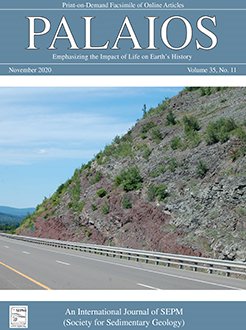The fluvial facies of the Catskill Formation record important ecological events that occurred during Late Devonian time. A well-exposed section between the towns of Blossburg and Covington, in north-central Pennsylvania, contains abundant macrofossils and sedimentary features, making it well-suited for linking Upper Devonian fossil occurrences with depositional environments and sedimentary processes. Strata consist of two distinct fluvial facies: floodplain lithofacies consist of mudrocks, with evidence of pedogenic overprinting and sharp-based sandstones interpreted as crevasse splays; channel-bar lithofacies consist of single- and multi-storied cross-stratified lenticular sandstone bodies interpreted as fluvial channel-bar complexes. Macrofossils occur in 22 discrete horizons spanning > 240 m of stratigraphic succession that include Archanodon bivalve shell impressions, two genera of “placoderms” (Bothriolepis, Phyllolepis), an unidentified acanthodian, and several taxa of sarcopterygian fishes, including lungfish (Dipnoi indet.), Holoptychius, Langlieria, and Sauripterus. Most vertebrate macrofossils are preserved as disarticulated, abraded plates, scales, and bone fragments in sandstone channel-bar deposits. Articulated, unabraded remains are preserved in proximal floodplain deposits. Miospores recovered from Catskill Formation fossil sites in the Blossburg-Covington section belong to the COR subzone of the VCo (Diducites versabilis-Grandispora cornuta) palynological zone, indicating deposition ca. 362 to 361.8 Ma during the late Famennian stage of the Late Devonian. Catskill Formation fluvial strata exposed tens of kilometers to the south and west yield latest Famennian palynomorphs. These broadly contemporaneous continental depositional environments supported Late Devonian vertebrate evolution, including the fin-to-limb transition in tetrapodomorphs, and the possible euryhalinity of vertebrates occupying marine-to-nonmarine transitional habitats.
How to translate text using browser tools
7 December 2020
VERTEBRATE TAPHONOMY, PALEONTOLOGY, SEDIMENTOLOGY, AND PALYNOLOGY OF A FOSSILIFEROUS LATE DEVONIAN FLUVIAL SUCCESSION, CATSKILL FORMATION, NORTH-CENTRAL PENNSYLVANIA, USA
David R. Broussard,
Cayla J. Treaster,
Jeffrey M. Trop,
Edward B. Daeschler,
Pierre A. Zippi,
Matthew B. Vrazo,
Michael C. Rygel
ACCESS THE FULL ARTICLE
It is not available for individual sale.
This article is only available to subscribers.
It is not available for individual sale.
It is not available for individual sale.
<
Previous Article
|

PALAIOS
Vol. 35 • No. 11
November 2020
Vol. 35 • No. 11
November 2020




